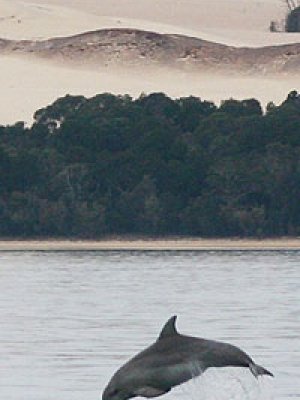
A UQ Science student’s research on the bottlenose dolphin population of Moreton Bay is so important, a German TV documentary crew has flown half way round the world to film it.
PhD Student Ina Ansmann will feature in the nature documentary series Exploring with Dirk Steffens discussing her research on the social and genetic population structure of the dolphins and how they should be managed.
“Near-shore populations of dolphins are particularly vulnerable due to their proximity to human habitation,” said Ms Ansmann, from the Marine Vertebrate Ecology Research Group in the School of Biological Sciences.
“Moreton Bay is one of the few ecosystems that still supports large populations of marine mammals in spite of its location adjacent to a major urban development.
“Effective management is crucial to preserving Moreton Bay as a significant wildlife habitat as well as an area used commercially and recreationally by an increasing human population.”
Having left her native Germany over nine years ago, Ms Ansmann said she was very excited to have her work appearing in a documentary series so heavily focussed on conservation.
“I’ve always been interested in nature documentaries and participating in this will be a great opportunity to get some experience in working with the media,” she said.
“It’s also brilliant to have my work appear on German national television, that way all my friends and family at home can finally get a better idea of what it is I’m doing down here. They seem to think I’m on permanent vacation.
“It’s only a shame it won’t get shown here, I’m still trying to find funding for the remainder of my project.”
Ms Ansmann is currently conducting boat-based surveys of Moreton Bay, recording sighting locations, group composition and behavioural data and taking individual photographs of the dolphins she encounters.
“Individual dolphins can be identified based on the shape of their dorsal fin,” Ms Ansmann said.
“Using photo-identification, I will analyse association patterns between dolphins, for example whether certain animals are seen together more often than others. That is, whether there are social groupings.”
Ms Ansmann is also collecting small skin and blubber samples from the dolphins for genetic testing.
“I then compare the social structures I’ve identified from the photos with the genetic differences within and between dolphin groups, based on their DNA sequences,” she said.
So far, Ms Ansmann has collected biopsy samples from 51 different dolphins in Moreton Bay and photographically identified 227, sighting over half of the dolphins more than once and some up to six times.
“I’ve given them all names to help me remember/recognise them when I see them out in the field, although I’ve had to enlist the help of my friends to come up with so many names,” she said.
Ms Ansmann also plans to examine the distribution, habitat use and different foraging strategies, such as feeding on the unwanted catch of prawn trawlers, of the social and/or genetic groupings.
“I’m starting to see some social and distribution patterns – some dolphins seem to regularly hang out with each other, and hang out in certain areas of the bay,” she said.
“But I need to collect more data before I can confirm this statistically.”
Ms Ansmann said the results of her study would indicate whether the population should be managed as panmictic - where individuals move freely within the whole bay - or as several distinct entities with different habitat and resource requirements.
“Knowledge of social and genetic structuring within the population is crucial for developing appropriate management strategies,” she said.
Ms Ansmann is now seeking volunteers to assist with fieldwork for her research in July to September this year, and from January to March next year. Interested people can contact her by email a.ina@gmx.net
Ms Ansmann will be filmed at UQ’s Moreton Bay Research station over the 18th and 19th of May.
Media: Ina Ansmann (+61 7 3365 7523) or Travis Taylor (+61 7 3365 8598).
.jpg)



